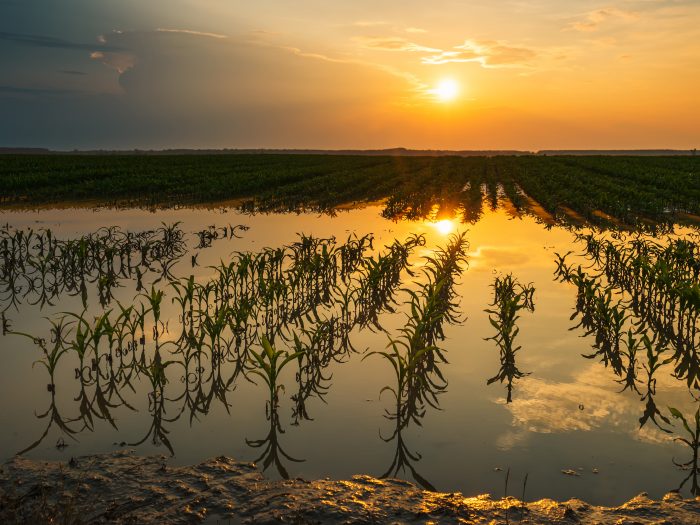Sponsored: Great American Insurance Group
Protecting America’s Farmers from the Perfect Storm of Volatile Weather and Global Competition

The agriculture sector sees a lot of uncertainties each year, which can negatively impact a farmer or rancher’s year-end revenue. 2020 has shown how extreme these challenges can be and why the agriculture industry needs a means to protect itself from these growing risks.
“Farmers and ranchers have a need for protection that guarantees them an appropriate amount of yield at a price that is reflective of the market when disaster strikes,” said Tim Weber, president, Great American Insurance Group Crop Division.
“Crop insurance can help by providing both yield protection and price protection.”
Growers often obtain financing to cover the expenses for their upcoming crop year. One benefit of crop insurance is that growers can leverage their crop insurance coverage as collateral. If a devastating weather event destroys their crop, their insurance helps to cover operating expenses and satisfy their loans so they can continue operations the next year.
With crop insurance, growers are able to more strategically and aggressively market their agriculture commodities in the face of uncertainty.
While increasing global competition and volatile weather are always concerns for farmers and ranchers, this year highlights why crop insurance is even more vital.
Here are two ways in which crop insurance provides the added value and protection needed to overcome these obstacles.
1) Price risk is becoming more prevalent in the ag economy that has been changed by COVID-19, trade relations and global competition.

Tim Weber, President, Great American Insurance Group Crop Division
The agriculture industry is keeping an eye on ever-increasing price risk.
One key dynamic unique to 2020 relates to the current COVID-19 outbreak. While the virus itself has no effect on yield, the decrease in drivers on the road has driven down the demand for corn-based ethanol.
“Approximately 35% of the U.S. corn crop is used to produce ethanol,” Weber said. “It is well documented that people are driving less since the outbreak of COVID-19, particularly in the early days of the pandemic. This reduced demand for fuel subsequently drove down the demand for ethanol.”
As a result, he said market pricing for corn dropped nearly 15% during mid-summer.
Additionally, other factors also affect pricing. Trade relations with China in recent years have resulted in added pricing pressure on the ag sector. Tariffs stemming from these trade relationships have put a strain on ag commodities, particularly on soybean prices. And because of the tariffs imposed on U.S. ag commodities, our growers are disadvantaged in the current global marketplace.
“The American farmer is seeing more global competition, particularly from South America. That affects the supply side of agriculture and puts pressure on pricing,” Weber said.
Crop insurance is designed to mitigate the effect of a price decline during the growing season.
“Crop insurance helps provide added protection from fluctuating prices.”
2) Extreme weather patterns are growing in severity every year.

Dale Perry, Senior Vice President, Great American Insurance Crop Division
2020, not unlike the last few years, has had its fair share of weather-related catastrophes. Increased weather volatility also keeps the agriculture industry on its toes.
“This year, we’ve seen overactive tropical storm activity, with 25 named storms as of early October. We’re on pace to break the all-time record of 28 named tropical storms set back in 2005,” according to Weber. “The U.S. has experienced nine named storms that made landfall in south Texas and in the southeastern United States, devastating cotton and citrus crops.”
While there has been too much rain in certain parts of the country, record heat and drought across much of the western third of the U.S. contributed to devastating fires along the west coast. While these fires harm and destroy crops in their path, their heavy smoke also deteriorates the quality of wine grapes, causing a condition known as smoke taint. Smoke-tainted grapes impair the flavor of the finished wine, causing them to be difficult to market.
Drought conditions also negatively affected corn and soybean yields within the Corn Belt. The drought started in the western Corn Belt, expanded into a late season drought in the eastern Corn Belt and affected what was shaping up to be a record corn and soybean crop.
“Generally speaking, 70-75% of all losses within a given year center around either too much or too little moisture,” says Weber. “In 2019, more than 19 million acres qualified for a ‘prevented planting’ loss due to record spring rains. While the 2020 crop year fared better than last year, growers were prevented from planting nearly twice the historical average number of acres that are typically unable to be planted in a given year.”
Wind, too, is becoming a more prevalent cause of crop damage than in the past.
“The derecho event that occurred on August 10 that stretched from the Dakotas to Ohio was the most damaging Midwest wind event that I’ve witnessed in my 30+-year career,” Weber explained. This particular storm came with little warning, had recorded winds as high as 112 MPH in some areas, and brought with it rapidly moving thunderstorms and tornado-equivalent damage.
Iowa, the nation’s leading corn-producing state in the country, was hardest hit. According to the USDA, 8.2 million acres of Iowa corn were damaged in about five hours. Industry wide, this affected 58,000 policyholders who represent approximately $6 billion in insured liability.
With crop insurance, growers have confidence that even in the event they may lose a portion of their crop to these increasingly dramatic weather events, they will be able to recover for the next growing season.
“Purchasing adequate crop insurance protection gives growers an opportunity to leverage their coverage to develop a marketing strategy with confidence. They know that their crop insurance policy will react and help compensate them in the event weather prevents them from being able to produce the bushels necessary to fulfill a contract,” said Weber.
Finding the Right Crop Insurer and Added Services to Meet Your Needs
The agriculture sector understands the need for coverage against unavoidable crop loss and other disruptions to its growing and selling season. Hailstorms, wind events, drought, excess moisture, market fluctuations — these unknowns can easily throw a wrench in well-laid plans, so farmers and ranchers want protection that will last.
As Weber said, “Crop insurance will help provide financial security for our farmers and ranchers.”
Great American is just one of 14 providers authorized under the Multiple Peril Crop Insurance (MPCI) program, which is approved by the federal government. Great American entered into this public-private relationship in 1981 and operates its crop insurance program under a set of standard rates, terms and conditions across the industry as established by the government.
“Because of the amount of time we’ve been in this space, our team has a vast understanding and deep knowledge of the program, which enables us to serve our customers well,” Weber said.
Additionally, Great American offers customers a suite of technology solutions designed to streamline the coverage process.
Dale Perry, senior vice president within Great American’s Crop Division, elaborated: “One of the largest challenges an agent or a grower has is reporting the information required to establish their coverage. Our technology makes this easy for them.”
The team at Great American created a platform that allows growers to report both their annual amount of acreage by field and crop, and their annual production or yield from that acreage. “Our mobile platform allows our growers to easily report through electronic means what was planted and was harvested,” Perry said.
This streamlined reporting approach creates efficiency for everyone involved. The farmers and ranchers can input this important information, and their Great American agent is able to interact and process this data to secure proper coverage for the insured. Additionally, the agent can meet with the insured and complete the entire process through their own mobile device, as needed.
“This is a process that works,” Perry said. “We develop our technology with input from our agents to make sure that they are comfortable with our offerings. By making sure they are part of the process, we’ve seen increased adoption by both them and our insureds.”
To learn more, visit GreatAmericanCrop.com.
Policies are underwritten by Great American Insurance Company and Great American Alliance Insurance Company, authorized insurers in all 50 states and DC, 301 E. Fourth St., Cincinnati, OH 45202. Great American is an equal opportunity provider.
This article was produced by the R&I Brand Studio, a unit of the advertising department of Risk & Insurance, in collaboration with Great American Insurance Group. The editorial staff of Risk & Insurance had no role in its preparation.










